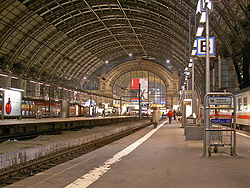This article needs additional citations for verification .(December 2014) |

A train shed is a building adjacent to a station building where the tracks and platforms of a railway station are covered by a roof. It is also known as an overall roof. It should not be confused with a carriage shed, whose primary purpose is to store and protect from the elements train cars not in use.
Contents
- Types of train shed
- Early wooden train sheds
- Classic metal and glass
- Concrete
- Modern steel and glass
- Open-air canopy
- Car barn
- See also
- References
- Bibliography
The first train shed was built in 1830 at Liverpool's Crown Street Station. [1]
The biggest train sheds were often built as an arch of glass and iron, while the smaller were built as normal pitched roofs.
The train shed with the biggest single span ever built was that at the second Philadelphia Broad Street Station, built in 1891.















